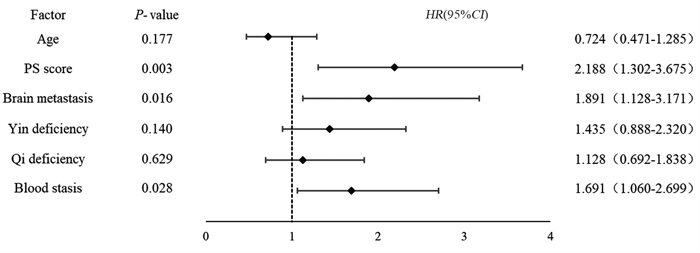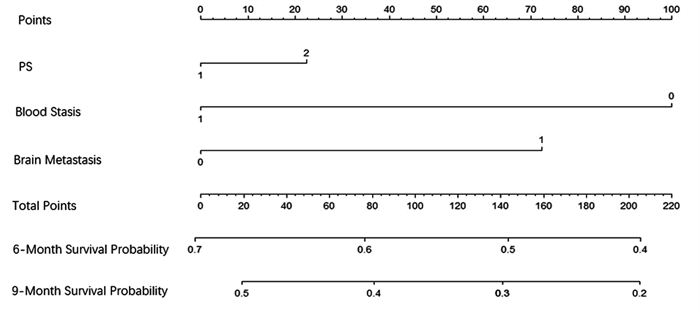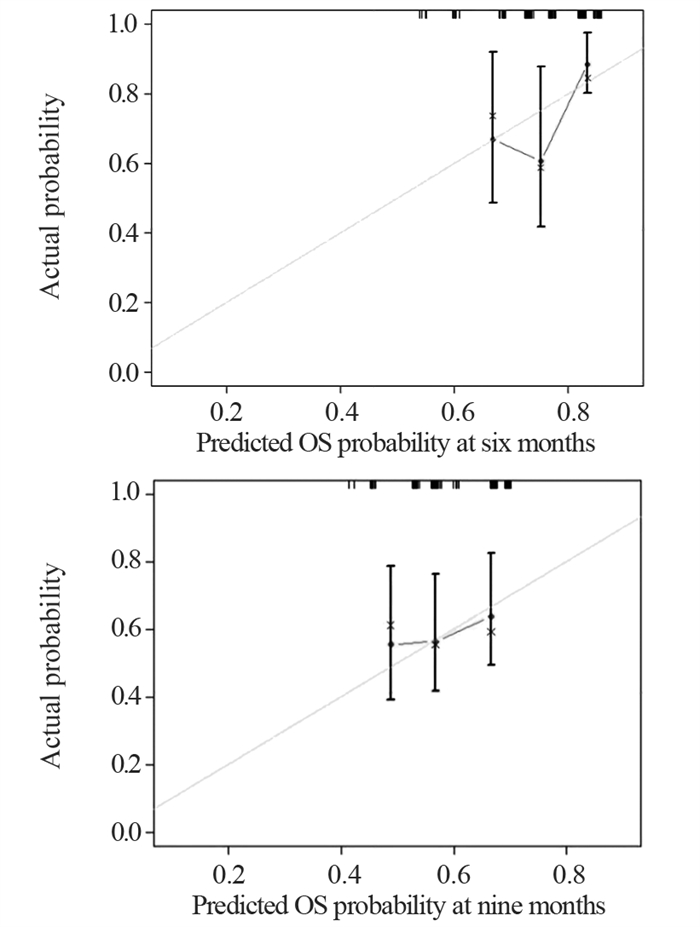Prediction Model of Treatment Effect of Anlotinib on Extensive-stage Small Cell Lung Cancer Based on Combination of Disease and Syndrome Information
-
摘要:目的
构建中医证素参与的安罗替尼治疗既往接受过多线化疗进展的广泛期小细胞肺癌(ES-SCLC)患者预后的列线图预测模型。
方法回顾性分析至少经过2个周期安罗替尼治疗的127例ES-SCLC患者临床资料。采用Kaplan-Meier法分析各个因素与总生存时间的关系,通过Cox回归分析筛选患者预后的独立影响因素,应用R语言构建列线图预测模型,采用C-index指数对模型进行评估,并以校准曲线来验证模型的准确性。
结果K-M法单因素生存分析显示,年龄、PS评分、脑转移、气虚病性证素、阴虚病性证素、血瘀病性证素是安罗替尼治疗ES-SCLC的相关危险因素。多因素Cox回归分析显示,PS评分(HR=2.188, P=0.003)、脑转移(HR=1.891, P=0.016)、血瘀病性证素(HR=1.691, P=0.028)是独立的预后不良因素。基于这三个独立影响因素建立预测安罗替尼治疗ES-SCLC患者预后的列线图模型,预测风险接近实际风险,显示出较高吻合度。
结论以PS评分、血瘀病性证素、脑转移为独立因素建立的列线图模型可以预测安罗替尼二三线治疗ES-SCLC患者的预后。
Abstract:ObjectiveTo construct a nomogram prediction model for the treatment effect of anlotinib with the participation of traditional Chinese medicine syndrome elements on the patients with extensive-stage small cell lung cancer (ES-SCLC) who previously received multiple lines of chemotherapy.
MethodsThe clinical data of 127 patients with ES-SCLC who received at least two cycles of anlotinib treatment were retrospectively studied. Kaplan-Meier method was used to analyze the relationship between each factor and the overall survival time. Cox regression analysis was applied to screen the independent influencing factors of the prognosis of patients with ES-SCLC. R language was employed to build a nomogram prediction model, C-index was used to evaluate the model, and calibration curve was adopted to verify the accuracy of the model.
ResultsAge, PS score, brain metastases, qi deficiency syndrome, yin deficiency syndrome, and blood stasis syndrome were related risk factors for ES-SCLC treated with anlotinib. PS score, brain metastasis, and blood stasis syndrome were independent prognostic factors. On the basis of these three independent influencing factors, a nomogram model was established to predict the prognosis of patients with ES-SCLC treated with anlotinib. The predicted risk was close to the actual risk, showing a high degree of coincidence.
ConclusionThe nomogram model established with PS score, blood stasis syndrome elements, and brain metastasis as independent factors can predict the prognosis of patients with ES-SCLC receiving second- and third-line treatment of anlotinib.
-
Competing interests: The authors declare that they have no competing interests.利益冲突声明:所有作者均声明不存在利益冲突。作者贡献:吴 琼:实验实施及论文撰写马军燕:分析、解释数据、撰写文章董量、李春阳:采集、分析、解释数据及技术和材料支持王志武:审阅和指导文章
-
表 1 127例广泛期SCLC患者的一般临床资料
Table 1 General clinical data of 127 patients with ESSCLC

表 2 127例广泛期SCLC患者的中医证素情况
Table 2 Distribution of traditional Chinese medicine syndrome elements in 127 patients with ES-SCLC

表 3 127例广泛期SCLC患者的疗效评价
Table 3 Efficacy evaluation of 127 patients with ES-SCLC

表 4 127例广泛期SCLC患者预后的单因素分析结果
Table 4 Univariate analysis of prognosis of 127 patients with ES-SCLC

-
[1] Poirier JT, George J, Owonikoko TK, et al. New approaches to SCLC therapy: from the laboratory to the clinic[J]. J Thorac Oncol, 2020, 15(4): 520-540. doi: 10.1016/j.jtho.2020.01.016
[2] Dingemans A-M C, Früh M, Ardizzoni A, et al. Small-cell lung cancer: ESMO Clinical Practice Guidelines for diagnosis, treatment and follow-up[J]. Ann Oncol, 2021, 32(7): 839-853. doi: 10.1016/j.annonc.2021.03.207
[3] Gözel S, Sumbul A, Sedef AM, et al. Influence of Creatinine Clearance on Survival Parameters in Small Cell Lung Cancer Treated with Cisplatin-Based Chemotherapy Regimen: Topic: Drug Treatment Alone and in Combination with Radiotherapy[J]. J Thoracic Oncol, 2017, 12(1): s701-s702. doi: 10.1016/j.jtho.2016.11.921
[4] Li D, Wei G, Li L, et al. Bronchopleural fistula in squamous cell lung cancer following anlotinib treatment: A case report[J]. Mol Clin Oncol, 2019, 11(6): 595-598. http://www.xueshufan.com/publication/2981329240
[5] 中国医师协会肿瘤医师分会, 中国临床肿瘤学会血管靶向治疗专家委员会, 中国抗癌协会肿瘤靶向治疗专业委员会. 盐酸安罗替尼治疗晚期肺癌中国专家共识(2020版)[J]. 中华肿瘤杂志, 2020, 42(10): 807-816. Oncologist Branch of Chinese Medical Doctor Association, Expert Committee of Vascular Targeted Therapy of Chinese Society of Clinical Oncology, Professional Committee of Targeted Therapy of Cancer of Chinese Anti-Cancer Association. Chinese expert consensus on the treatment of advanced lung cancer by antirotinib hydrochloride (2020 edition)[J]. Zhonghua Zhong Liu Za Zhi, 2020, 42(10): 807-816.
[6] Zhang Y, Jia B, Li J, et al. Anlotinib in treatment of an elderly patient with recurrent advanced SCLC[J]. Tumori, 2020, 106(6): NP36-NP40. doi: 10.1177/0300891619900673
[7] 张国伟, 程瑞瑞, 牛媛媛, 等. 安罗替尼单药治疗89例老年广泛期小细胞肺癌的疗效和安全性分析[J]. 肿瘤学杂志, 2022, 28(6): 479-484. https://www.cnki.com.cn/Article/CJFDTOTAL-XHON202206007.htm Zhang GW, Cheng RR, Niu YY, et al. Efficacy and Safety of antirotinib in the treatment of 89 elderly patients with extensive small cell lung cancer[J]. Zhong Liu Xue Za Zhi, 2002, 28(6): 479-484. https://www.cnki.com.cn/Article/CJFDTOTAL-XHON202206007.htm
[8] 王静怡, 董量, 付浩宇, 等. 安罗替尼二三线治疗的广泛期小细胞肺癌患者预后分析[J]. 中国临床医生杂志, 2021, 49(1): 38-41. https://www.cnki.com.cn/Article/CJFDTOTAL-ZLYS202101012.htm Wang JY, Dong L, Fu HY, et al. Prognosis analysis of patients with extensive small cell lung cancer treated with second or third line antirotinib[J]. Zhongguo Lin Chuang Yi Sheng Za Zhi, 2021, 49(1): 38-41. https://www.cnki.com.cn/Article/CJFDTOTAL-ZLYS202101012.htm
[9] 卢美君, 赵燕仪, 康马飞. 影响安罗替尼临床疗效和预后的多因素分析[J]. 现代肿瘤医学, 2022, 30(10): 1831-1835. doi: 10.3969/j.issn.1672-4992.2022.10.023 Lu MJ, Zhao YY, Kang MF. Analysis of the factors influencing the clinical efficacy and prognosis of androtinib[J]. Xian Dai Zhong Liu Yi Xue, 2022, 30(10): 1831-1835. doi: 10.3969/j.issn.1672-4992.2022.10.023
[10] Li H, Liu Y, Liu X, et al. A novel multi-target tyrosine kinase inhibitor anlotinib combined with irinotecan has in-vitro anti-tumor activity against human small-cell lung cancer[J]. Anti-Cancer Drugs, 2020, 31(10): 1057-1064. doi: 10.1097/CAD.0000000000000969
[11] 中华人民共和国国家卫生健康委员会. 原发性肺癌诊疗指南(2022年版)[J]. 中国合理用药探索, 2022, 19(9): 1-28. https://www.cnki.com.cn/Article/CJFDTOTAL-ZYYS202209001.htm National Health Commission of the People's Republic of China. Guidelines for diagnosis and treatment of primary lung cancer (2022 edition)[J]. Zhongguo He Li Yong Yao Tan Suo, 2022, 19(9): 1-28. https://www.cnki.com.cn/Article/CJFDTOTAL-ZYYS202209001.htm
[12] 朱文锋. 证素辨证学[M]. 第1版. 北京: 人民卫生出版社, 2008: 88-90. Zhu WF. Syndrome element Differentiation[M]. 1st Ed. Beijing: People's Medical Publishing House, 2008: 88-90.
[13] 王蓉, 申洹浣, 谢书阳, 等. 不同年龄组小细胞肺癌的临床特征与预后影响因素分析[J]. 中国医院统计, 2022, 29(4): 246-252, 256. https://www.cnki.com.cn/Article/CJFDTOTAL-JTYY202204002.htm Wang R, Shen HH, Xie SY, et al. Analysis of clinical features and prognostic factors of small cell lung cancer in different age groups[J]. Zhongguo Yi Yuan Tong Ji, 2022, 29(4): 246-252, 256. https://www.cnki.com.cn/Article/CJFDTOTAL-JTYY202204002.htm
[14] 中华人民共和国卫生部. 中药新药临床研究指导原则(试行)[M]. 北京: 中国医药科技出版社, 2002: 216-224. Ministry of Health of the People's Republic of China. Guidelines for clinical research of New Chinese Medicine (Trial)[M]. Beijing: China Medical Science and Technology Press, 2002: 216-224.
[15] 王晶, 李凯. 小细胞肺癌治疗中的抗血管生成药物研究进展[J]. 中华肿瘤杂志, 2020, 42(8): 624-628. https://www.cnki.com.cn/Article/CJFDTOTAL-FAIZ202101012.htm Wang J, Li K. Research progress of anti-angiogenic drugs in the treatment of small cell lung cancer[J]. Zhonghua Zhong Liu Za Zhi, 2020, 42(8): 624-628. https://www.cnki.com.cn/Article/CJFDTOTAL-FAIZ202101012.htm
[16] Montanino A, Manzo A, Carillio G, et al. Angiogenesis inhibitors in small cell lung cancer[J]. Front Oncol, 2021, 11: 655316.
[17] Xu Q, Gu J, Lv Y, et al. Angiogenesis for tumor vascular normalization of Endostar on hepatoma 22 tumor-bearing mice is involved in the immune response[J]. Oncol Lett, 2018, 15(3): 3437-3446. doi: 10.3892/ol.2018.7734/download
[18] Rodríguez-Remírez M, del Puerto-Nevado L, Fernández-Aceñero MJ, et al. Targeting galectin-1 by aflibercept strongly enhances its antitumor effect in neuroendocrine carcinomas[J]. Neuroendocrinology, 2021, 111(1-2): 146-157. http://pubmed.ncbi.nlm.nih.gov/31991407/
[19] Gao X, Peng L, Zhang L, et al. Real-world efficacy and safety of anlotinib as third- or further-line treatment in refractory small cell lung cancer[J]. J Cancer Res Clin Oncol, 2022, 148(10): 2661-2671. doi: 10.1007/s00432-021-03848-4
[20] 肖琳, 王志武, 宣立功, 等. 晚期非小细胞肺癌安罗替尼治疗后中医证型与近期疗效相关性因素的分析[J]. 辽宁中医杂志, 2022, 49(9): 74-78. https://www.cnki.com.cn/Article/CJFDTOTAL-LNZY202209021.htm Xiao L, Wang ZW, Xuan LG, et al. Analysis of correlation factors between TCM syndrome type and short-term curative effect after treatment of advanced non-small cell lung cancer with antirotinib[J]. Liaoning Zhong Yi Za Zhi, 2022, 49(9): 74-78. https://www.cnki.com.cn/Article/CJFDTOTAL-LNZY202209021.htm
[21] 周卫东, 袁庆, 艾瑛, 等. 不同中医证型肺鳞癌患者的化疗疗效及其中医干预疗效[J]. 实用医学杂志, 2020, 36(5): 677-681. https://www.cnki.com.cn/Article/CJFDTOTAL-SYYZ202005028.htm Zhou WD, Yuan Q, Ai Y, et al. Therapeutic effect of chemotherapy and TCM intervention in patients with lung squamous cell carcinoma with different TCM syndroms[J]. Shi Yong Yi Xue Za Zhi, 2020, 36(5): 677-681. https://www.cnki.com.cn/Article/CJFDTOTAL-SYYZ202005028.htm
[22] 芦希艳, 姚家久, 赵宁侠. 中医辨证辅助化疗治疗非小细胞肺癌的临床疗效及对患者免疫功能和预后的影响[J]. 癌症进展, 2022, 20(8): 797-799, 804. https://www.cnki.com.cn/Article/CJFDTOTAL-AZJZ202208005.htm Lu XY, Yao JJ, Zhao NX. Clinical efficacy of TCM syndrome differentiation and adjuvant chemotherapy in the treatment of non-small cell lung cancer[J]. Ai Zheng Jin Zhan, 2002, 20(8): 797-799, 804. https://www.cnki.com.cn/Article/CJFDTOTAL-AZJZ202208005.htm
[23] Chen T, Tang M, Xu X, et al. Inflammation-based prognostic scoring system for predicting the prognosis of advanced small cell lung cancer patients receiving anlotinib monotherapy[J]. J Clin Lab Anal, 2022, 36(12): e24772.
[24] Wu D, Nie J, Hu W, et al. A phaseⅡ study of anlotinib in 45 patients with relapsed small cell lung cancer[J]. Int J Cancer, 2020, 147(12): 3453-3460. http://pubmed.ncbi.nlm.nih.gov/32557583/




 下载:
下载:



